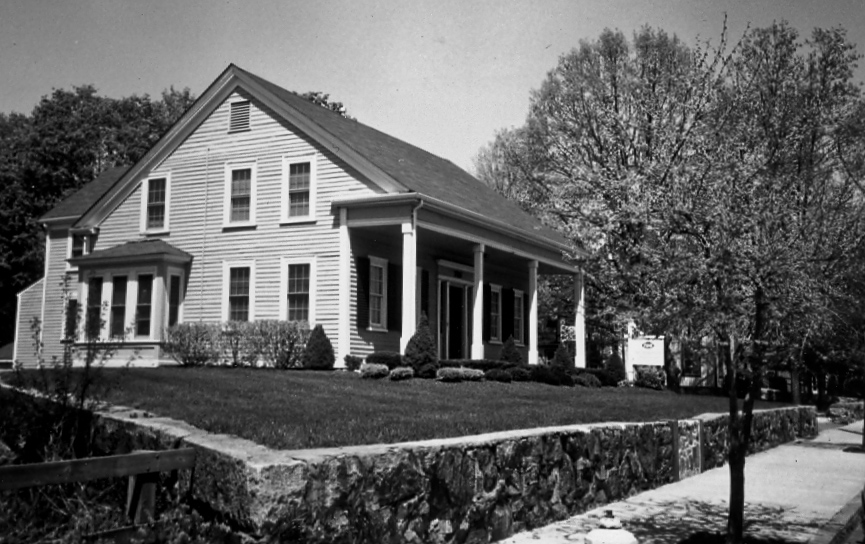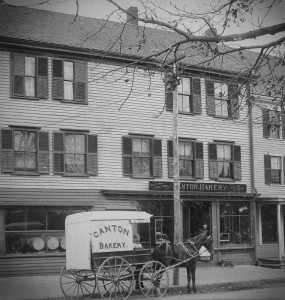True Tales: Billings House ~ Filling in the Past
By George T. Comeau
The Billings House at Canton Center in a 2002 photograph (Arthur Krim, courtesy of the Canton Historical Commission)
What happens when time and architectural tastes shift and a historic building becomes so transformed as to actually lose all integrity and fall out of its historical importance? For several weeks I have been watching the work at the small cottage near the Canton Center railroad station. A local dentist who has purchased the commercial property is creating a professional building and has transformed this historic building. The original building has been standing on this lot for over 175 years and is an important part of our downtown landscape.
Known historically as the Billings House, this diminutive Federal-style cottage was constructed by William Billings, who was a carpenter by trade. The house was a perfect example of a traditional center hall cottage. These small cottage-style houses were built just after the railroad came through Canton at a time when the population was beginning to expand.
Billings was born in Canton in 1807, and by age 28 he had purchased a lot of land with buildings from Elijah Endicott’s estate. The house may have been built as early as 1835 or as late as 1838 and constructed in what was just becoming the new center of the community. Industry was beginning to boom — Paul Revere’s copper rolling mill and the Ames Shovel Company were the “heavies” as they found their home along the tributaries leading to the East Branch of the Neponset River.
It would not be long before the quiet little house would rumble as a result of the construction of the new Stoughton Branch Railroad in 1846. The property shares the southerly boundaries with the railroad and the rail line figures prominently in the development of this house. Originally, there was an ell — a wing off the main building that ran perpendicular to the central portion of the house. It seems that this side of the house was removed in 1890 and was replaced with the square bay window that you can still see today facing the railroad tracks. It was at this time that the rear portion, a new ell, was added to the back of the building. The cause of all these changes was the fact that the railroad double tracked the line through Canton Center in 1890.
By 1852, Billings decided to move to Thompson, Connecticut, and left the town that he loved. After 15 years in Connecticut, Billings moved back to Canton, where he lived until his death in 1887 at age 79. The obituary that recorded his passing noted, “Once again the grim destroyer, Death, has carried to another world another of Canton’s best-known citizens in the demise of William Billings.” The paper continued, “Mr. Billings was a carpenter by trade, and nearly every house within sight of the depot is a monument to the excellence of his work.”
Billings was universally loved and revered in our small community of mid 19th century Canton. His passing saddened many, owing to his pleasant and agreeable demeanor and the fact that “he was never at a loss with kind words and wishes for everybody.” It was in his passing that he left his house to his wife, who built the addition as a result of the expanding rail line.
In 1902 the Billings House changed hands and was purchased by Josie and Hiram Poole. The Pooles were a family of bakers and owned the Canton Bakery. The family is best known through Elsie Poole, the daughter of Josie and Hiram. Elsie was born in Canton in 1895 and in 1936 married Thomas Hayes. It would be Elsie, the beloved piano teacher, who would live in the Billings House that was purchased by her mother. The sound of the piano could be heard wafting over the tree-lined street on summer afternoons. Elsie Poole held a long-kept secret for many years, and the unspeakable family tragedy that happened to her father when she was only 8 years old can now be shared.
What would become known as the Poole murder was something that was never spoken of in Elsie’s family. On the night of August 2, 1903, Hiram Poole was leading his cow home along the road on Sherman Street. In the vicinity of Memorial Hall he encountered a very drunk man by the name of Rosario DiSano. By all accounts DiSano, who was from Stoughton, had a very rough day. After his breakfast on that August day, he and a friend traveled to Canton to get a bicycle repaired. He apparently spent the day drinking, and by nightfall it was impossible for him to ride back to Stoughton.
While standing on the corner of Sherman and Washington streets waiting for the streetcar, he encountered a roving gang of youths. The youths, numbering six or seven, teased the immigrant and upon escalation threw stones at DiSano, whereupon he fell down and was beaten up a bit. A chase ensued and the inebriated DiSano lost the boys up Sherman Street, where he encountered Poole. DiSano testified that upon running into “a man with a rope,” that man “had a rope with which he struck me with.”
DiSano, claiming self-defense, used a large knife and slashed at Poole repeatedly before running away. The witnesses — and there were several — describe the gruesome scene at 10:15 that evening. Dr. William Tenney’s firsthand description reported that Poole personally “reached his side at 10:18. He was lying on the sidewalk on Washington Street. He was alive, but unconscious. Found a wound over the collarbone, from which blood was flowing. There was another over the breastbone. There was a wound on his chin. He lived three or four minutes after he arrived.” It was the neck wound — the one that severed the jugular vein — that ended 44-year-old Hiram Poole’s life.
It took the jury less than 45 minutes to find DiSano guilty of murder in the second degree, for which he served a life sentence. The effect on the family was profound. Immediately after her husband’s murder, Josie Poole closed his business and disposed of his property. The plan was to move herself and her daughters to Maine, but apparently this did not happen. Town reports and marriage records show that Mrs. Poole and her two daughters remained in Canton and continued to live in the Billings House.
Elsie Poole Hayes kept a yellowed newspaper clipping that detailed the trial. On May 29, 1966, Hayes handed the clipping to Katherine Sullivan, president of the Canton Historical Society, “under the expressed and agreed conditions that the material be neither discussed or published during her lifetime — as she does not wish to be the object of sympathy or interest now that the tragedy is forgotten by the public.” Elsie Poole Hayes died in 1989. This was the private life of the Poole family in Canton.
The Billings House remained in the hands of the Poole family through the mid 1940s. In 1997 the house was converted to offices and soon thereafter was awarded a preservation commendation from the Canton Historical Commission.
Dr. Arthur Krim, a consultant for the Historical Commission, noted in 2002 that the house deserves to be on the National Register of Historic Places. In his report he writes of the importance of this early 19th century suburban cottage that predates the railroad. Most striking of this house’s features are the Federal styles seen in the doorway with pilaster sidelights and molded lintel.
Today, what we see evolving at the Billings House is the total destruction of any of the Federal-style features that figure so prominently in the architectural significance of this artifact. Of course, owners are free to do what they will with their private property, but the new stucco building with artificial corners, plastic and modern materials demolishes the once charming demeanor of this historic site. I call it an M&M — the hard candy shell obliterating the history that was one of the finest cottages in Canton, and one that is now only available for viewing in archival photos. Like the cavities of the teeth that will soon be filled within this new building, history suffers decay.
Short URL: https://www.thecantoncitizen.com/?p=9656












